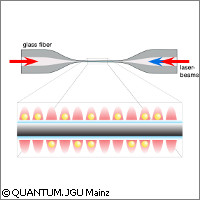Possibilities abound for new quantum interface
German physicists have created a quantum interface that connects light particles and atoms, an essential part of improving the capacity of quantum technologies. The interface may even bring physics one step closer to the realisation of the first quantum computer. Findings from the research are published in the journal Physical Review Letters. In their paper, the scientists from the Johannes Gutenberg University Mainz in Germany explain that both trapping and optically interfacing laser-cooled neutral atoms is fundamental to their use in advanced quantum technologies. The team managed to achieve both through the interaction of caesium atoms with a multi-colour evanescent field surrounding an optical nanofibre. Essentially, these atoms are trapped using laser light that travels through an ultra-thin, tapered glass fibre (so thin that it measures just one hundredth of the diameter of a human hair). The centre of the fibre is even thinner than the light itself. No longer restricted to the inside of the nanofibre, the light then extends into the space surrounding the fibre (creating the evanescent field) and couples to the trapped atoms. The result is a glass fibre-based quantum interface that can be used to transmit quantum information; it is an essential requirement for large-scale quantum communication schemes such as secure data transmission via quantum cryptography. The scientists also believe the interface is well suited to the realisation of hybrid quantum systems that combine atoms with, for instance, solid state quantum devices. Research leader, Mainz University's Dr Arno Rauschenbeutel, added that the interface 'might also prove useful for the realisation of a quantum computer'. While the computers we use today are based on transistors, the concept of a quantum computer relies on quantum mechanical phenomena. We are still far from realising this goal, but large-scale quantum computers would revolutionise the way we work. Glass fibre networks, on the other hand, are already a fundamental part of modern communication (our telephones and the Internet rely primarily on optical data transmission using glass fibre cables). The light that travels through these networks consists of indivisible energy quanta or photons (a discovery made by Albert Einstein). Each photon is able to then transmit one bit of information (corresponding to two states, zero or one). As quantum objects, photons can exist simultaneously in both of these states. This property, for example, is behind quantum cryptography, which protects us against eavesdropping. To make full use of the possibilities that quantum communication offers, we must be able to store the quantum information that is encoded on each photon. Since photons are not suited to performing this particular task, physicists believe it would be better to transfer the quantum information to atoms. This, in turn, requires an interface between the photons and atoms that could be easily applied to glass fibre networks.
Countries
Germany



